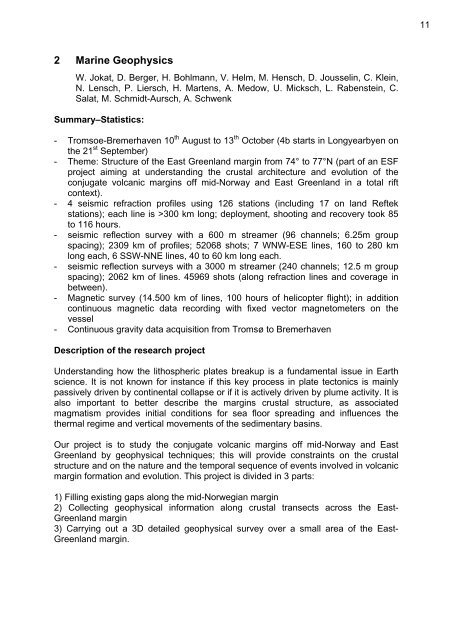the Expedition ARKTIS-XIX/4 of the research vessel POLARSTERN ...
the Expedition ARKTIS-XIX/4 of the research vessel POLARSTERN ...
the Expedition ARKTIS-XIX/4 of the research vessel POLARSTERN ...
Create successful ePaper yourself
Turn your PDF publications into a flip-book with our unique Google optimized e-Paper software.
2 Marine Geophysics<br />
W. Jokat, D. Berger, H. Bohlmann, V. Helm, M. Hensch, D. Jousselin, C. Klein,<br />
N. Lensch, P. Liersch, H. Martens, A. Medow, U. Micksch, L. Rabenstein, C.<br />
Salat, M. Schmidt-Aursch, A. Schwenk<br />
Summary–Statistics:<br />
- Tromsoe-Bremerhaven 10 th August to 13 th October (4b starts in Longyearbyen on<br />
<strong>the</strong> 21 st September)<br />
- Theme: Structure <strong>of</strong> <strong>the</strong> East Greenland margin from 74° to 77°N (part <strong>of</strong> an ESF<br />
project aiming at understanding <strong>the</strong> crustal architecture and evolution <strong>of</strong> <strong>the</strong><br />
conjugate volcanic margins <strong>of</strong>f mid-Norway and East Greenland in a total rift<br />
context).<br />
- 4 seismic refraction pr<strong>of</strong>iles using 126 stations (including 17 on land Reftek<br />
stations); each line is >300 km long; deployment, shooting and recovery took 85<br />
to 116 hours.<br />
- seismic reflection survey with a 600 m streamer (96 channels; 6.25m group<br />
spacing); 2309 km <strong>of</strong> pr<strong>of</strong>iles; 52068 shots; 7 WNW-ESE lines, 160 to 280 km<br />
long each, 6 SSW-NNE lines, 40 to 60 km long each.<br />
- seismic reflection surveys with a 3000 m streamer (240 channels; 12.5 m group<br />
spacing); 2062 km <strong>of</strong> lines. 45969 shots (along refraction lines and coverage in<br />
between).<br />
- Magnetic survey (14.500 km <strong>of</strong> lines, 100 hours <strong>of</strong> helicopter flight); in addition<br />
continuous magnetic data recording with fixed vector magnetometers on <strong>the</strong><br />
<strong>vessel</strong><br />
- Continuous gravity data acquisition from Tromsø to Bremerhaven<br />
Description <strong>of</strong> <strong>the</strong> <strong>research</strong> project<br />
Understanding how <strong>the</strong> lithospheric plates breakup is a fundamental issue in Earth<br />
science. It is not known for instance if this key process in plate tectonics is mainly<br />
passively driven by continental collapse or if it is actively driven by plume activity. It is<br />
also important to better describe <strong>the</strong> margins crustal structure, as associated<br />
magmatism provides initial conditions for sea floor spreading and influences <strong>the</strong><br />
<strong>the</strong>rmal regime and vertical movements <strong>of</strong> <strong>the</strong> sedimentary basins.<br />
Our project is to study <strong>the</strong> conjugate volcanic margins <strong>of</strong>f mid-Norway and East<br />
Greenland by geophysical techniques; this will provide constraints on <strong>the</strong> crustal<br />
structure and on <strong>the</strong> nature and <strong>the</strong> temporal sequence <strong>of</strong> events involved in volcanic<br />
margin formation and evolution. This project is divided in 3 parts:<br />
1) Filling existing gaps along <strong>the</strong> mid-Norwegian margin<br />
2) Collecting geophysical information along crustal transects across <strong>the</strong> East-<br />
Greenland margin<br />
3) Carrying out a 3D detailed geophysical survey over a small area <strong>of</strong> <strong>the</strong> East-<br />
Greenland margin.<br />
11

















